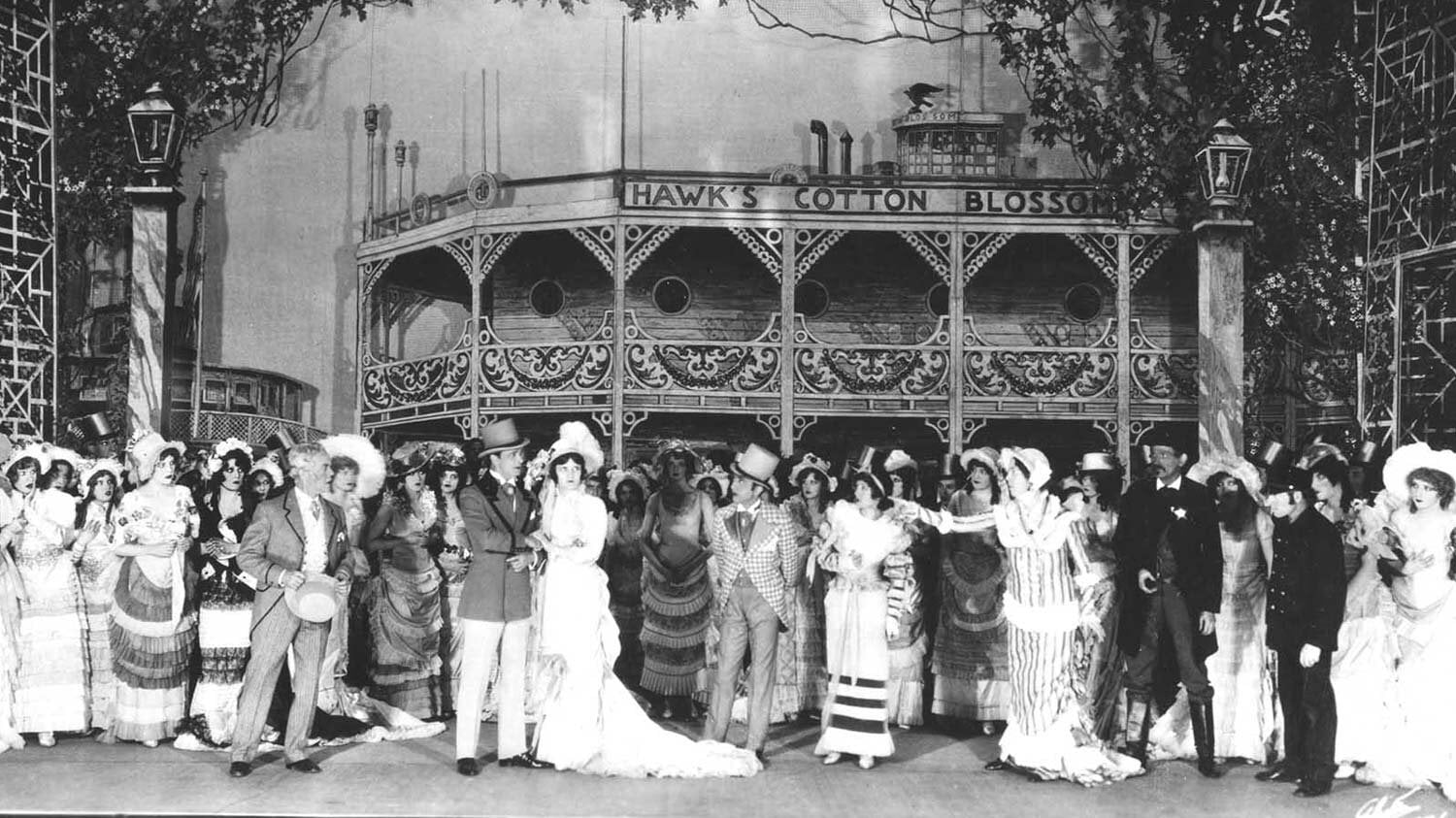When Show Boat opened at New York’s Ziegfeld Theatre on December 27, 1927, it marked a revolutionary moment in the American musical theater.
Audiences were confronted with a new kind of work which was neither a frothy operetta, nor a loosely constructed Jazz Age musical comedy. The Musical Play was born, with its serious, dramatic themes, and integration of music and dialogue.
An entry in The Complete Book of Light Opera includes this description:
Here we come to a completely new genre – the musical play as distinguished from musical comedy. Now…the play was the thing, and everything else was subservient to that play. Now…came complete integration of song, humor and production numbers into a single and inextricable artistic entity.
It was the idea of composer Jerome Kern to adapt Edna Ferber’s 1926 novel, Show Boat, into a musical. Far from the exuberant escapism common on Broadway at the time, the story revolved around subjects such as racism, alcoholism, and marital strife. The action takes place on a floating theater (the Cotton Blossom) on the Mississippi River during the 40 years spanning 1887 and 1927. Magnolia Ravenal, the naive daughter of the boat’s owner, falls in love with a charming gambler, Gaylord Ravenal. The couple marries, but Gaylord ultimately leaves Magnolia, gambling away their fortune. Julie LaVerne, a performer on the Cotton Blossom, loses her job when it is revealed that she his half African-American. (Interracial marriage was forbidden in the Jim Crow south). Against this backdrop, Joe, an African-American dock worker, comments on human struggles and the eternal flow of time and the River (O’l Man River).
According to theater historian, John Kenrick,
After the opening night audience filed out of the Ziegfeld Theatre in near silence, [the show’s producer] Florenz Ziegfeld thought his worst fears had been confirmed. He was pleasantly surprised when the next morning brought ecstatic reviews and long lines at the box office. In fact, Show Boat proved to be the most lasting accomplishment of Ziegfeld’s career – the only one of his shows that is regularly performed today.
In collaboration with Kern, Oscar Hammerstein II, who wrote the lyrics and book, created something new and boldly dramatic. (Its complex and nuanced portrayal of African-American characters alongside whites was as revolutionary as its form). Show Boat planted the seeds for Rodgers and Hammerstein musicals to come. In his final years, Hammerstein mentored the young Stephen Sondheim, who pushed the genre to its zenith.
Here are seven key excerpts from Show Boat. Most of the examples come from John McGlinn’s landmark 1988 cast album, with Karla Burns, Jerry Hadley, Bruce Hubbard, Frederica von Stade and Teresa Stratas with the Ambrosian Chorus and the London Sinfonietta. McGlinn, a conductor and musical theater archivist, restored the original 1927 version, including most of Kern’s underscoring music, with orchestrations by Robert Russell Bennett.
Overture
Setting the stage for the turbulent drama to follow, the original Overture is not the typical melodic medley. One of its most prominent themes is the shadowy Mis’ry’s Comin’ Aroun, cut from the show during trials in Washington, D.C. Deemed extraneous to the drama, the theme establishes the atmosphere before the curtain rises.
Where’s the Mate for Me?/Make Believe
In this extended musical sequence, we hear the seeds of the groundbreaking “Bench Scene” from Rodgers and Hammerstein’s Carousel. Dreamy and tentative, the lyrics anticipate the indirectness of Hammerstein’s People Will Say We’re in Love from Oklahoma!, and If I Loved You (from Carousel’s “Bench Scene”). Kern’s melody gracefully recalls the Viennese operetta music of Franz Lehar.
In the beginning of the first act, this duet comes soon after the initial meeting of the teenage Magnolia and Gaylord. In the second act, just before leaving Magnolia as a result of compulsive gambling, Gaylord sings the song to their young daughter. He instructs her to sing it whenever she is lonely, and to pretend that he has never left.
Ol’ Man River
In 1951, the legendary American concert bass-baritone William Warfield recorded Ol’ Man River in one take for the soundtrack of the MGM film version of Show Boat. This performance comes from the 1962 studio cast recording:
Can’t Help Lovin’ Dat Man
When Julie sings this bluesy melody to Magnolia, the song is soon taken up by Queenie, the cook, and a chorus of others.
You Are Love
Kern returns to the world of operetta in this slow waltz ballad, sung by Magnolia and Gaylord:
Why do I Love You?
In this duet from the second act, Magnolia and Gaylord express their continuing love for one another, despite challenges:
Bill
Initially, Jerome Kern wrote the song Bill with lyricist P. G. Wodehouse for the 1917 musical Oh, Lady! Lady!!. The melancholy and introspective song was cut from that show. Hammerstein revised the lyrics, and the song was inserted into Show Boat‘s nightclub scene. Julie, now abandoned by her white husband and succumbing to alcoholism, sings it as an audition song.
Recordings
- Kern: Show Boat – John McGlinn / Frederica von Stade, Teresa Stratas, Jerry Hadley, Bruce Hubbard, Karla Burns, David Garrison, Paige O’Hara, Robert Nichols, Nancy Kulp, Lillian Gish Amazon
- Kern: Show Boat (1962 studio recording) Amazon
Featured Image: a scene from the original 1927 production of “Show Boat”


Goodness, Mr. Judd: it doesn’t seem like your articles about show music get much love. Well, you’ve definitely got a fan on this end. Thank you!